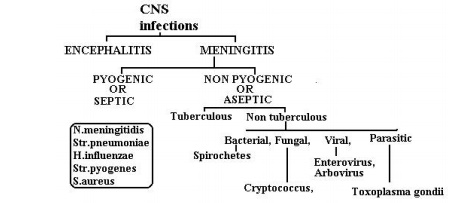Chapter: Microbiology
Infections of the Central Nervous System
INFECTIONS OF THE CENTRAL NERVOUS SYSTEM
Infecting agents reach the central nervous system (CNS) from the blood or by direct invasion or by ascending through the nerves. The infection of the CNS can be classified as encephalitis and meningitis.
Meningitis- Etiological agents
Meningitis is the inflammation of the membranes covering the brain (meninges). This can be caused by a wide range of micro-organisms. This can be classified as follows:

Acute pyogenic meningitis
This condition is related to the age of the patients. Coliform ba-cilli and group B streptococci are common cause in neonates. Haemophilus and Neisseria meningitidis are frequently seen in children. H.influenzae and Str.pneumoniae are commonly found in adults.N.meningitidis can cause infections in all age groups. Other organisms involved are Str.pyogenes, S.aureus, Salmonella species, Listeria.
Pathogenesis and Epidemiology :Neonatal meningitis
In early days, it was caused by Str.pyogenes and S.aureus. But in later years coliform bacilli are most commonly found. Coliform men-ingitis results in congenital deformities and the source of the organisms can be genito-urinary tract, lungs and umbilicus.
Haemophilus meningitis: This occurs mainly in young children be-tween the ages of 3 months to 5 years. Protection before 3 months is given by maternal antibody and after 5 months by acquired immunity. Infection spreads through blood stream.
Meningococcal meningitis (N.meningitidis) :The organism entersthe body via the naso-pharynx, where they may produce localized in-flammatory reaction or remain silent. By two ways they may reach the meninges. 1. They spread directly along the spaces between the sheath and the branches of the olfactory nerve that pierce the cribriform plate. 2. The organisms invade the blood stream, either produce transient bacteremia or multiply in the blood. They cause lesions in the skin, adrenal glands, joints and meninges. There are nine groups of menin-gococci. Infections spread to one another by close contact.
Pneumococcal meningitis : Subsequent to some conditions like lo-bar pneumonia, otitis media, or infection of the para nasal sinus, or injury to skull, Streptococcus pneumoniae multiplies in the blood and spread to the meninges.
Meningitis due to other bacteria : Staphylococcus and Streptococ-cus pyogenes reach the meninges via blood or directly from the exte-rior after a trauma.
Tuberculous meningitis :This occurs in a severe form in young chil-dren and is secondary to a tuberculous focus elsewhere in the body. The bacilli reach the meninges via the blood.
Laboratory Diagnosis
Laboratory diagnosis is made by isolation and identification of specific organism from blood and Cerebrospinal fluid (CSF). Antigen can be detected by counter immunoelectrophoresis or latex agglutina-tion test. Blood cultures are useful in 50% cases. Gram stain and acid fast stains are useful in demonstrating the bacteria in the CSF. Fluores-cence microscopy is useful for tuberculous meningitis. Fontana’s stain-ing is useful for spirochetes like leptospira, borrelia and treponema.
Once organisms are grown, they are identified by standard biochemi-cal tests. Treatment will depend on the nature of the organisms and the antibiotic susceptibility pattern
Viral meningitis
Viruses are the most frequent cause of meningitis. Most cases are due to enteroviruses, ECHO and Coxsackie viruses. Mumps virus can cause meningitis in children.
Pathogenesis :Viruses enter by oral or respiratory routes. They es-tablish a silent initial focus somewhere in the naso-pharynx or in small bowel. The spread occurs through lymph to the blood. They mainly multiply in lymphoreticular system. The infection is detectable after 5 days. The virus is free in the plasma. They affect the meninges and they may spread to other parts also. This time fever and neck stiffness occur. At this time the virus appears in the throat and gut also. Serum antibody appears about this time.
Diagnosis :Specimens of throat secretions, feces, CSF, are collectedduring acute phase. During convalescent period feces may be obtained. Enteroviruses can be isolated in tissue cultures. No specific therapy is available.
Related Topics